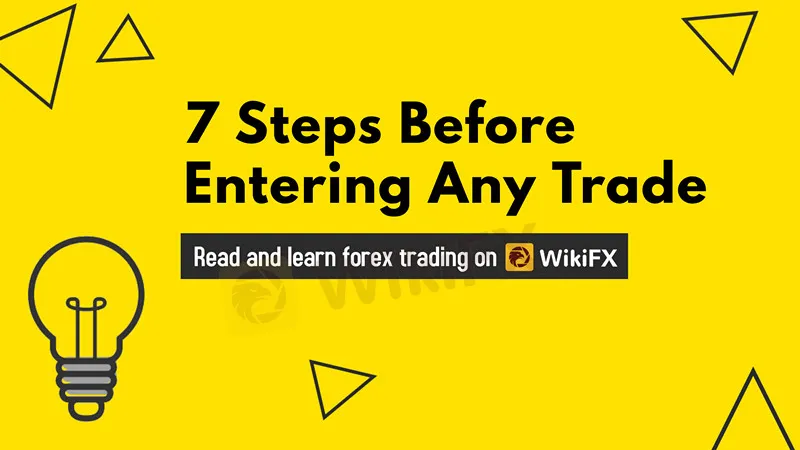简体中文
繁體中文
English
Pусский
日本語
ภาษาไทย
Tiếng Việt
Bahasa Indonesia
Español
हिन्दी
Filippiiniläinen
Français
Deutsch
Português
Türkçe
한국어
العربية
7 Steps Before Entering Any Trade
Abstract:Before entering a trade, ask yourself the following questions.

Before entering a trade, ask yourself the following questions:
Is the market trending or ranging?
Is there a significant level of support or resistance nearby?
Is the trade confirmed by an indicator?
What is the risk to reward ratio?
How much capital am I risking?
Are there any significant economic releases that can impact the trade?
Am I following the trading plan?
1) IS THE MARKET TRENDING OR RANGING?
Trending markets
Experienced traders know that finding a strong trend and trading in the trends direction, has the potential to lead to higher probability trades.
There is a well-known saying that trending markets have the ability to bail traders out of bad entries. Even if a trader entered a short trade after the trend was well established, the trend would continue to provide more pips to the downside than to the upside.
Traders need to ask themselves if the market is exhibiting signs of a strong trend and whether ‘trend trading’ forms part of the trading plan.
Ranging markets
Ranging markets tend to see price bounce between support and resistance to trade within a channel. Certain markets, like the Asian trading session, tend to trade in ranges. Oscillating indicators (RSI, CCI and Stochastic) can be of great use to traders that focus on range trading.
2) IS THERE A SIGNIFICANT LEVEL OF SUPPORT OR RESISTANCE NEARBY?
Price action tends to respect certain price levels for a number of reasons and being able to identify these levels is key. Traders do not want to be holding a short position after price has dropped to the key level of support, only to bounce back higher.

The same applies when price approaches a key level of resistance and typically drops lower shortly after. Trend traders typically look for sustained breaks of these levels as an indication that the market may start to trend. Range traders will on the other hand, look for price to bounce between support and resistance for prolonged periods.
3) IS THE TRADE CONFIRMED BY AN INDICATOR?
Indicators assist traders in confirming high probability trades. Depending on the trading plan and strategy, traders will have one or two indicators that complement the trading strategy. Do not fall into the trap of over-complicating the analysis by adding multiple indicators to a single chart. Keep the analysis clean and simple and easy to view at a glance.
4) WHAT IS THE RISK TO REWARD RATIO?
The risk to reward ratio is the ratio of the number of pips that traders will risk in the hopes of reaching the target. According to our Traits of Successful Traders research, which analysed over 30 million live trades, traders with a positive risk to reward ratio were nearly three times more likely to be profitable than those who do not. For example, a 1:2 ratio means that a trader risks half of what he/she stands to gain if the trade works out. The image below further depicts this principle.

5) HOW MUCH CAPITAL AM I RISKING?
It is essential for traders to ask this question. Often traders blow up their accounts by leveraging the account to the maximum when chasing “sure things”. One way to avoid this is to limit the leverage used on all trades to ten to one, or less. Another helpful tip is to set stops on all trades and ensure that the aggregate amount risked is no more then 5% of the account balance.
Before placing a trade, ask yourself, “how much capital should I use?”
6) ARE THERE ANY SIGNIFICANT ECONOMIC RELEASES THAT CAN IMPACT THE TRADE?
Sudden market news has the potential to invalidate the “perfect” trade. While it is almost impossible to anticipate things like, acts of terror, natural disasters or systemic failures in the financial markets, traders can plan for economic releases like NFP, CPI, PMI and GDP releases.
7) AM I FOLLOWING THE TRADING PLAN?
All of the above is of very little use if it does not tie in with the trading plan. Deviating from the trading plan will result in mixed results and only frustrate the trading process. Keep to the trading plan and do not place trades unless the trading checklist has been completed and confirms the trade may be executed.
- END -

Disclaimer:
The views in this article only represent the author's personal views, and do not constitute investment advice on this platform. This platform does not guarantee the accuracy, completeness and timeliness of the information in the article, and will not be liable for any loss caused by the use of or reliance on the information in the article.
Read more

The best and most profitable strategies to trade Forex 2021
A quality Forex trading strategy should contain a minimum of indicators, be simple and at the same time bring good profits.

How to Trade Forex News?
In the Forex market, all strategies based on the reactions of traders to macroeconomic events happening in the world right now are called trading the news.
WikiFX Broker
Latest News
Why is there so much exposure against PrimeX Capital?
Russia to Fully Ban Crypto Mining in 10 Regions Starting January 1, 2025
Two Californians Indicted for $22 Million Crypto and NFT Fraud
WikiFX Review: Is Ultima Markets Legit?
Colorado Duo Accused of $8M Investment Fraud Scheme
What Impact Does Japan’s Positive Output Gap Have on the Yen?
Malaysia Pioneers Zakat Payments with Cryptocurrencies
FCA's Warning to Brokers: Don't Ignore!
OFX: Is It Good to Go? Broker Review
Financial Educator “Spark Liang” Involved in an Investment Scam?!
Currency Calculator


